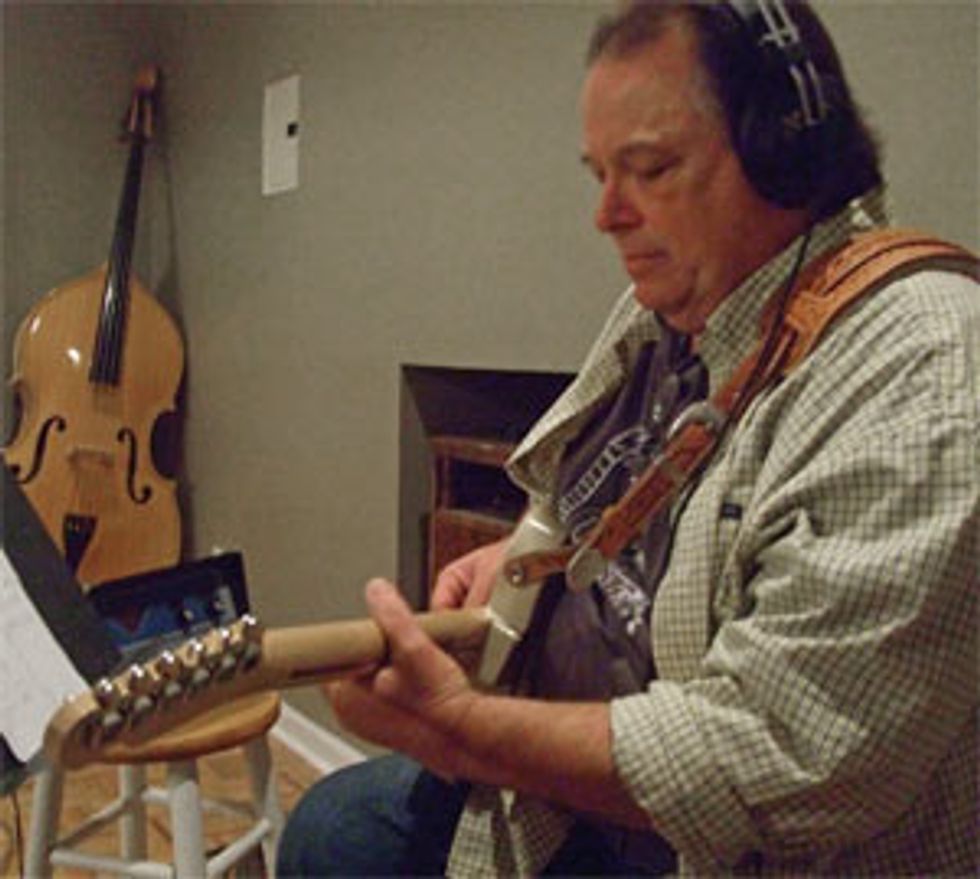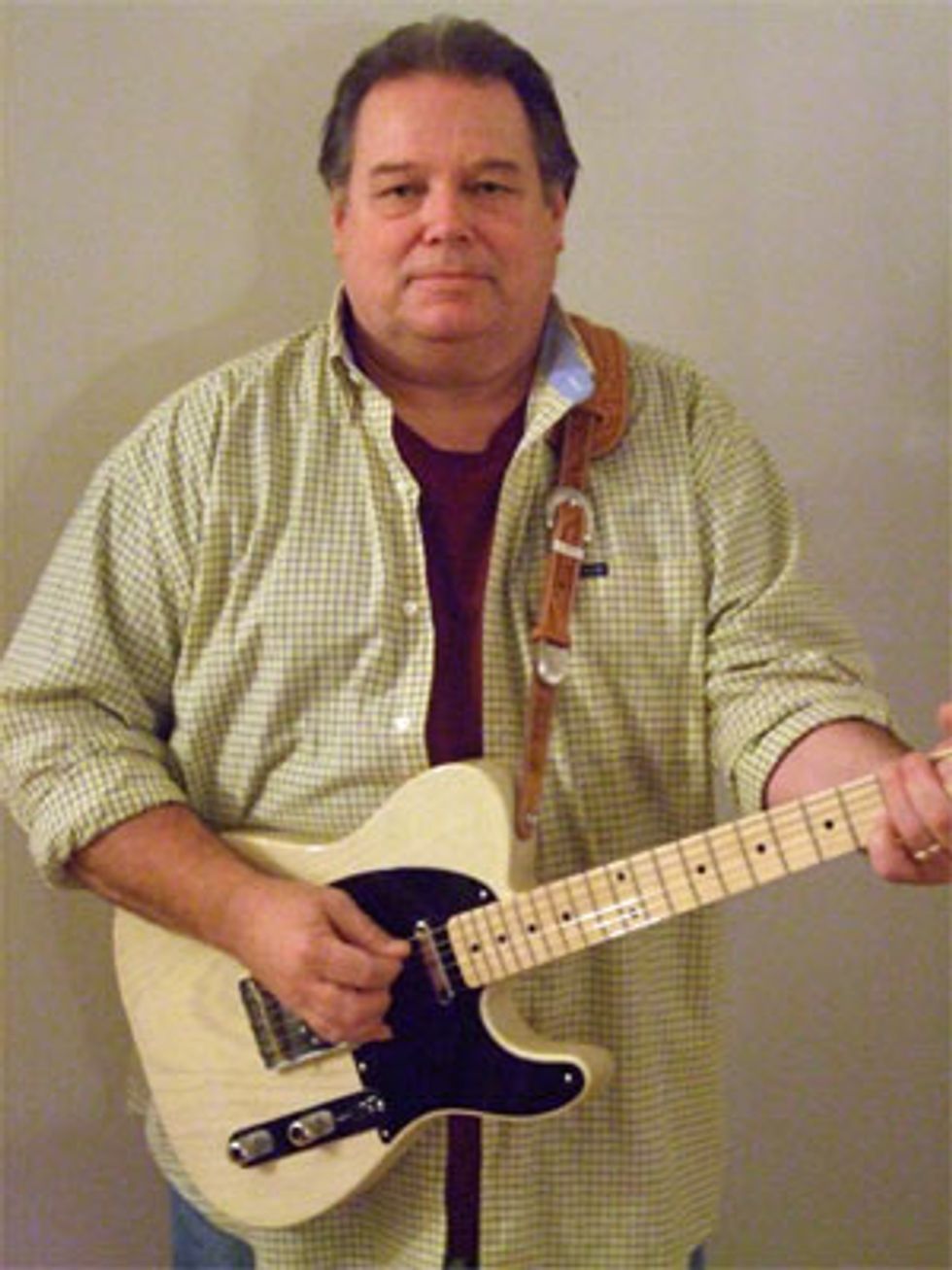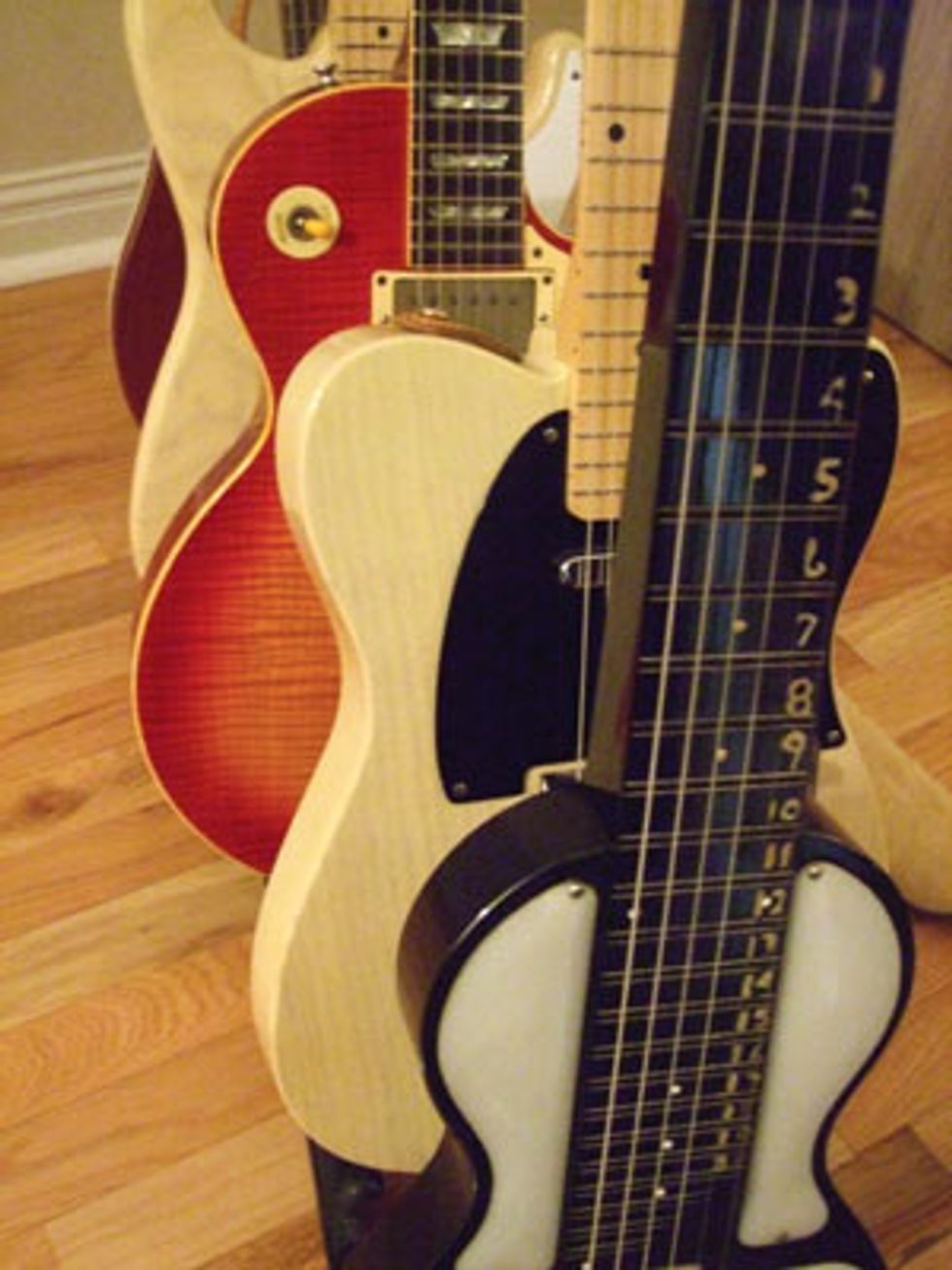 |
|
On top of all that, Bill Hullett is one of the nicest guys around and a real family man. I had the chance to talk to him about music, guitars, and life in general.
Bill, when, how, and why did you came to Nashville?
I moved to Nashville in August 1978, when I was 28, with my wife, Debbie, my son Clay (who was 1-1/2), and all our possessions in a van and a U-Haul trailer… what was I thinking! I had always wanted to be a session musician ever since I was about sixteen. I don't remember how I had even heard that there was such a job, but the second that I knew about it, I knew that it was the job I wanted in life!
What was your first gig in Nashville?
Debbie played bass guitar—very well, I might add—and we both played a few little local country bars here in town. But within about a month of living here in Nashville, we met Pete Drake (studio owner and session steel player) and he let us start hanging out at his studio, watching sessions and meeting people. Opportunities like that don't exist anymore for new people coming to town. It was wonderful because you never knew who was going to stop by at Pete's. His studio was right on Music Row, and something was always going on there...
What are your most important musical influences?
Well, when I first took up the guitar the coolest bands were the Beach Boys, and other “surf bands," but once the Beatles were on Ed Sullivan, I was hooked big time to all the English guys. At the same time, I was listening to C&W radio stations, too, and I loved Buck Owens records. We lived in San Jose, California, so it was pretty easy to find Buck on the radio. Later, I really became a fan of Eric Clapton when I saw him on the first Cream US tour... and I saw him just a few short months later as a backing guitarist for Delaney and Bonnie. He was a major influence from that point on, at least as far as blues and rock. As far as country, I loved Don Rich (with Buck Owens) and Roy Nichols (with Merle Haggard). I was a big Waylon fan—this was in the mid-sixties. I thought that I was listening to Waylon play guitar, only to find out later that those early records featured Wayne Moss on electric… the early Haggard stuff was James Burton. It added more to the mystique of “session players" in my mind.
A few years later in the early seventies, before moving to town, I became a big Reggie Young fan. I would buy any record regardless of who the artists were, as long as Reggie played guitar on it. When I finally moved to town and got to know him as a friend it was the absolute best! My hero became my friend.

One memorable moment was about 1979. I had just started doing some sessions for Pete Drake and a very few others in town. Pete had pulled some strings and got me on a couple of sessions for a guy named Eddie Fox. He was a guy that ran a sixteen track recording studio that Marty Robbins owned, and if someone that Marty met out on the road wanted to cut a little record he would send them to Eddie. Well, Eddie called me one day when I was hanging out at Pete's studio—they were only about 1/2 block apart. He asked if I had my guitars with me, because he had some acoustic parts that needed redoing, and he asked if I would mind helping him out. I said “Sure," figuring it might be a freebie but it would be worth it to get in Eddie's good graces... I walked in the studio and there was Marty Robbins! Eddie introduced me and went on to say that Marty needed some rhythm guitar tracks on two or three songs. Marty asked the engineer to clear off two tracks per song and told him that I'd be laying down acoustic parts and doubling the parts (very common to the Nashville sound of acoustics). The engineer said to Marty that there was only one open track per song, so we had problems... well, Marty asked me if I had a second acoustic with me. I said yes, and we proceeded to put two acoustics down at once on one mic, and there I was two feet from Marty in a guitar face-off! He was incredibly nice and fun to work for, and to a newcomer at the time, I was in Session Heaven! By the way, he let me sign “leader" on the time card, which meant double scale. A real prince of a guy!
What was the funniest thing that ever happened to you while playing music?
I was recording an album one time for B.J. Thomas, and we were in the middle of the session when Leon Russell walked in. The producer, Pete Drake, stopped us in the middle of the take and moved Pig Robbins over to the electric piano, and asked Leon to play the grand piano. We didn't even run it down any further. B.J. was cutting the gospel standard “Oh, Happy Day." Pete said, “Leon, you know this song, just wing it." We cut it in one take and it was fabulous... we all piled into the booth to listen, and Pete was really pleased. At the end of the playback, he looked up to ask Leon if he'd like to play on the next song, too. Leon had slipped off into the night… out the door and gone, just like the Lone Ranger or something. It was wild. Do you have any endorsements running? I don't do many endorsements, because I actually play the ones I do endorse—I know, call me crazy… I endorse Fender guitars, Glendale guitar bridges, Alan Hamel guitar pickups, Bob Sweet pedals, a lubricant called “Nutsauce," and my oldest son, Clay Hullett, builds all my amps. Currently, I use two of his Tweed 4x10 Bassman-style amps, and two of his Tweed Deluxe-style amps. I love all of these products. Any time you see me playing, you can rest assured that I'm using all these folks' gear. I endorse all their stuff because it's the absolute best of the best.
Do you have a favorite guitar, amp and effect and why they are your favorites?
My favorite electric guitar is a Fender Telecaster or Esquire. I've used them the most for over thirty years, and I think it's too late to try to change me—although I carry a great Strat and a Les Paul with me to sessions, and use them as well. The Tele is my “go to first" electric. For acoustic, my favorites are two that I own. One is a 1961 Martin D-21. I've used it on many Nashville records—Merle Haggard, George Jones, Tammy Wynette, Martina McBride, etc. The other favorite acoustic is a 1964 Epiphone Texan. It's a perfect twin to one that Paul McCartney uses all the time. It sounds great… and very Beatles-like, I might add.
What was your first guitar ever, and do you still own and play it?
My first guitar was a nice, shiny new Japanese one-pickup electric called a Rodeo; it was awful… horrible action and even worse tone. I paid $39 for it in 1964. The real kicker though is that I passed up a Fender Broadcaster for $25 because it was too yellowed and beat up! (Ah, youth…)
What's your standard equipment for a live gig and for a studio session?
Live, I usually use one Tweed Bassman-style— that my son Clay builds—and a pedalboard. On the pedalboard, I have a Keeley compressor, two Expandora distortions, a Fulltone Fulldrive II, a Dunlop Tremulator and a Line 6 delay pedal. I usually just use a Tele live. For sessions, I take that and much more of everything: amps, pedals and guitars. You never know what someone is going to ask for, so you always have to have that stuff handy.
If you had to go to a deserted island and could only take one guitar, one amp and one stompbox with you, what would they be? It would be a Telecaster for sure. I've built a Brian Poe bodied Telecaster with Alan Hamel pickups that may be the best Tele I've ever owned. I could get by with that one… If it's an island gig I guess I wouldn't have to play too loud! So I'd say the one amp that I'd bring would be the little tweed Deluxe that my son Clay builds… it's a very beautiful amp—very touch sensitive. I'd load a bunch of NOS tubes in the back too! And one stompbox would be my Dunlop tremolo pedal because the amp can do all the variety of clean/dirty and that would be it. Maybe now that I think about it, maybe instead of the tremolo pedal, I'd take a Fulltone Echoplex! It is the best on the planet… yep, that's what I would take! And lots of George L cables…
What do you think is the key to your constant success as a session player?
Well, first off there are a few guys (Reggie Young to name one) that have done a whole lot more sessions than I have! But I will say that I've been very blessed with all the work I've been called to do over the years. If I had to say what I thought was the reason I get called, it's a couple of factors. One is that I consider myself a team player. If I strum acoustic all day, that's ok. If I play a mandolin part, that's ok, too. If you want me to bring in the electric, I'll gladly do that as well. Some guys want to play “hot rod guitar" all the time… successful session guys realize that it's the artists record that you're trying to enhance, not your career. But even more important than that, I think I bring a good vibe to the session, because I generally have a positive attitude. There is nothing worse than being trapped in a small recording studio with someone who's hard to get along with—those guys usually get weeded out pretty fast.
 |
When you're called to do a session, do you have any idea going in what you'll be doing?
We almost never do we know what we'll be doing… I've left the house and played Bluegrass acoustic in the morning, country Tele twangin' style in the afternoon, and then Memphis style R&B in the evening—and gotten up the next day and done even weirder combinations of stuff! We usually get to the session… someone will give us an idea of where to set up, and generally what instruments you might want to bring in from your car (I usually carry about a dozen different guitars with me). Then after everyone gets sounds—this might take twenty minutes—we listen to the work tape and either write a number chart or follow along with one that would have been written by the session leader the night before in some cases. Then we talk about it for about three minutes and go run it down, talk about five more minutes, and cut it for real. If it's not exactly right, we may cut it one more time, but generally speaking, it never goes too much further than that. Then the session guys will ask the engineer to punch a section or two if need be, and that will be a track. From the first listen of the work tape to a finished track might take 45 minutes to an hour… then it's “next please."
How many sessions do you do on a typical day?
Nashville sessions ninety percent of the time are run very orderly. The first session of the day is 10 am to 1 pm, the second session runs 2 to 5 pm, and the third session runs 6 to 9 pm. Very rarely these days, although quite frequently twenty years ago, is an evening session that runs from 10 pm to 1 am… a throw back to the beginning of Nashville, when there were just a few session guys and there always had to be order applied so that one session would never overlap with another—so that everyone could use the “A" Team during any given day. The town has always stuck to that schedule ever since. It's a great way to do it… just becomes habit after so long.
As far as typical… there is not a typical. I've done days when I've been back home after one session, and I've done weeks where I've had four sessions a day, every day! And basically felt like I was out on the road living in my van. I've done months where I had 50 or 60 sessions in a month, and slow months where I've had only a dozen or so… you never know what's ahead. You're always one phone call away from racing through traffic trying to get to the next studio on time.
How much of the tonality of a particular guitar do you think is in the player's hands and touch?
The longer I play, the more I'm inclined to believe that most of the tone that an instrument makes is a by-product of the hands and ears of the person playing it—cause I can't find any new tone! Seriously, I think you can just about “will" a guitar to do things. There's a guy I know from California that makes his Strat sound exactly like a big hollowbody Gibson with P-90s, like a switchmaster! It's the most uncanny thing I've ever seen… it's definitely in his ears and touch.
Are you planning to record a follow-up of your solo project Two-Lane Blacktop?
Yes, I am. I actually already have a good portion of it done. I'm working on a scheme for an unusual way to release it, so keep your eyes peeled... if I pull off my idea for distribution, I'll be sure to check back and let you know. Thanks for asking!
Bill's Gearbox
| Electric Guitars: 2 custom-made Teles (Brian Poe ash body, Allparts TMO Fat neck, Alan Hamel Broadcaster pickups, and Glendale bridge hardware) 1 custom-made Strat (USACustom body, Allparts Fat Strat neck, Alan Hamelpickups, Glendale three-piece strat bridge) Acoustic Guitars: 1961 D-21 Martin 1964 Epiphone Texan (a twin to Paul McCartney's) 1970 Guild 12 string 1917 A-3 Gibson Mandolin | Amps: 4x10 Hullett Tweed Bassman (handwired replica of a 1959 Bassman made by Clay Hullett) 1x12 Hullett Tweed Deluxe Egnater Rebel 20 1961 Gibson Ranger Effects: Analogman Bi-Comp compressor Bill's Websites: home.comcast.net/~bhullett/index.htm profile.myspace.com/billhullett |














![Rig Rundown: Russian Circles’ Mike Sullivan [2025]](https://www.premierguitar.com/media-library/youtube.jpg?id=62303631&width=1245&height=700&quality=70&coordinates=0%2C0%2C0%2C0)
















![Rig Rundown: AFI [2025]](https://www.premierguitar.com/media-library/youtube.jpg?id=62064741&width=1245&height=700&quality=70&coordinates=0%2C0%2C0%2C0)




















 Zach loves his Sovtek Mig 60 head, which he plays through a cab he built himself at a pipe-organ shop in Denver. Every glue joint is lined with thin leather for maximum air tightness, and it’s stocked with Celestion G12M Greenback speakers.
Zach loves his Sovtek Mig 60 head, which he plays through a cab he built himself at a pipe-organ shop in Denver. Every glue joint is lined with thin leather for maximum air tightness, and it’s stocked with Celestion G12M Greenback speakers.






